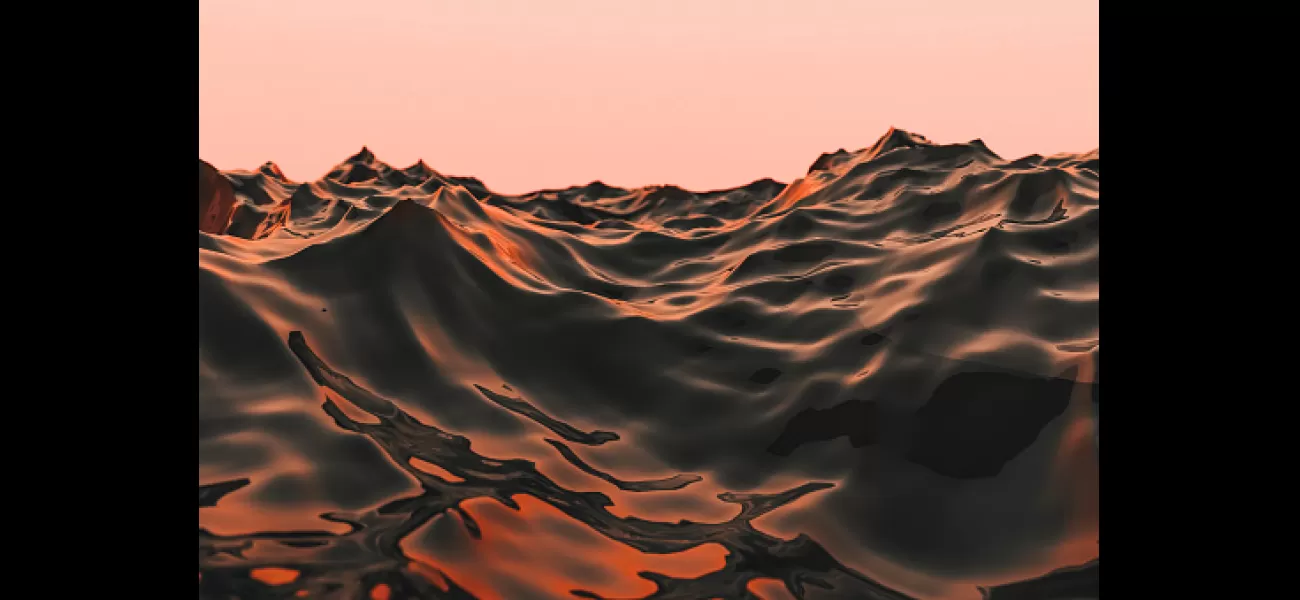New findings about a water planet with a hot sea are revealed by Webb.
Swimming not recommended.
March 8th 2024.

Imagine a distant world, 70 light years away, covered in a vast ocean of boiling water. This is TOI-270 d, a sub-Neptune exoplanet that has captured the attention of astronomers around the world. Through the powerful lens of the James Webb Space Telescope, we have been able to catch a glimpse of this mysterious water world, also known as a hycean planet.
The observations made by the telescope have revealed the presence of water vapor, methane, and carbon dioxide in TOI-270 d's atmosphere. These chemical signatures point to a planet that is mostly covered in water, with a hydrogen-rich atmosphere. However, the researchers from the University of Cambridge caution against picturing a typical ocean landscape on this planet.
Professor Nikku Madhusudhan, who led the analysis, explains that while the surface of TOI-270 d may be covered in water, the extreme temperatures would make it unlike any ocean we know on Earth. "The ocean could be upwards of 100 degrees or more," he says. The team suggests that this scorching hot ocean could still be liquid if the atmospheric pressure is high enough, but they also acknowledge that it may not be habitable for life as we know it.
The idea of a hycean planet has sparked a debate among scientists. A Canadian team has also detected the same atmospheric chemicals on TOI-270 d, but they believe that the planet would be too hot for liquid water. Instead, they propose that the planet has a rocky surface and a dense atmosphere of hydrogen and water vapor.
One interesting observation is that TOI-270 d lacks ammonia, a chemical that should naturally occur in a hydrogen-rich atmosphere. According to Professor Madhusudhan, this suggests that there may be a rocky core beneath the ocean, which would not allow ammonia to dissolve in the water.
Another factor that makes TOI-270 d unique is its tidal locking. This means that one side of the planet always faces its host star, while the other side is always in darkness. This creates a stark temperature contrast, with the day side being extremely hot and the night side potentially having more habitable conditions.
The conditions on TOI-270 d are extreme, with a crushing atmosphere that is tens or hundreds of times the pressure on Earth's surface. The ocean depths could reach tens to hundreds of kilometers, with a high-pressure ice seabed and a rocky core underneath.
Here are some key facts about TOI-270 d: It is a Neptune-like exoplanet orbiting an M-type star, with a mass of 4.78 Earths. It takes around 11.4 days to complete one orbit of its star, and it was first discovered in 2019. Additional observations by Professor Björn Benneke from the University of Montreal suggest that the planet may be too hot for liquid water to exist.
Despite the excitement surrounding the discovery of this water world, the researchers urge caution in interpreting their findings. Professor Benneke reminds us that the temperature on TOI-270 d is too warm for liquid water to exist, and the atmosphere contains too much water vapor for an ocean to be plausible. He compares the atmosphere to "a thick, hot fluid."
The presence of another chemical compound, carbon disulphide, has also sparked interest among scientists. This molecule has been linked to biology on Earth, but the researchers are careful not to jump to conclusions. "We can't tie [carbon disulphide] to biological activity," says Professor Madhusudhan. "But if we're able to measure it, it's promising that we should be able to detect habitable planets in the future."
In conclusion, while the discovery of TOI-270 d has given us a fascinating glimpse into the diversity of exoplanets, we must be cautious in our interpretations. As Professor Madhusudhan reminds us, "We need to be extremely careful about how we communicate findings on this kind of object. It's easy for the public to jump on to the idea that we're finding life already." The study detailing these findings has been published in the journal Astronomy and Astrophysics Letters.
The observations made by the telescope have revealed the presence of water vapor, methane, and carbon dioxide in TOI-270 d's atmosphere. These chemical signatures point to a planet that is mostly covered in water, with a hydrogen-rich atmosphere. However, the researchers from the University of Cambridge caution against picturing a typical ocean landscape on this planet.
Professor Nikku Madhusudhan, who led the analysis, explains that while the surface of TOI-270 d may be covered in water, the extreme temperatures would make it unlike any ocean we know on Earth. "The ocean could be upwards of 100 degrees or more," he says. The team suggests that this scorching hot ocean could still be liquid if the atmospheric pressure is high enough, but they also acknowledge that it may not be habitable for life as we know it.
The idea of a hycean planet has sparked a debate among scientists. A Canadian team has also detected the same atmospheric chemicals on TOI-270 d, but they believe that the planet would be too hot for liquid water. Instead, they propose that the planet has a rocky surface and a dense atmosphere of hydrogen and water vapor.
One interesting observation is that TOI-270 d lacks ammonia, a chemical that should naturally occur in a hydrogen-rich atmosphere. According to Professor Madhusudhan, this suggests that there may be a rocky core beneath the ocean, which would not allow ammonia to dissolve in the water.
Another factor that makes TOI-270 d unique is its tidal locking. This means that one side of the planet always faces its host star, while the other side is always in darkness. This creates a stark temperature contrast, with the day side being extremely hot and the night side potentially having more habitable conditions.
The conditions on TOI-270 d are extreme, with a crushing atmosphere that is tens or hundreds of times the pressure on Earth's surface. The ocean depths could reach tens to hundreds of kilometers, with a high-pressure ice seabed and a rocky core underneath.
Here are some key facts about TOI-270 d: It is a Neptune-like exoplanet orbiting an M-type star, with a mass of 4.78 Earths. It takes around 11.4 days to complete one orbit of its star, and it was first discovered in 2019. Additional observations by Professor Björn Benneke from the University of Montreal suggest that the planet may be too hot for liquid water to exist.
Despite the excitement surrounding the discovery of this water world, the researchers urge caution in interpreting their findings. Professor Benneke reminds us that the temperature on TOI-270 d is too warm for liquid water to exist, and the atmosphere contains too much water vapor for an ocean to be plausible. He compares the atmosphere to "a thick, hot fluid."
The presence of another chemical compound, carbon disulphide, has also sparked interest among scientists. This molecule has been linked to biology on Earth, but the researchers are careful not to jump to conclusions. "We can't tie [carbon disulphide] to biological activity," says Professor Madhusudhan. "But if we're able to measure it, it's promising that we should be able to detect habitable planets in the future."
In conclusion, while the discovery of TOI-270 d has given us a fascinating glimpse into the diversity of exoplanets, we must be cautious in our interpretations. As Professor Madhusudhan reminds us, "We need to be extremely careful about how we communicate findings on this kind of object. It's easy for the public to jump on to the idea that we're finding life already." The study detailing these findings has been published in the journal Astronomy and Astrophysics Letters.
[This article has been trending online recently and has been generated with AI. Your feed is customized.]
[Generative AI is experimental.]
0
0
Submit Comment





